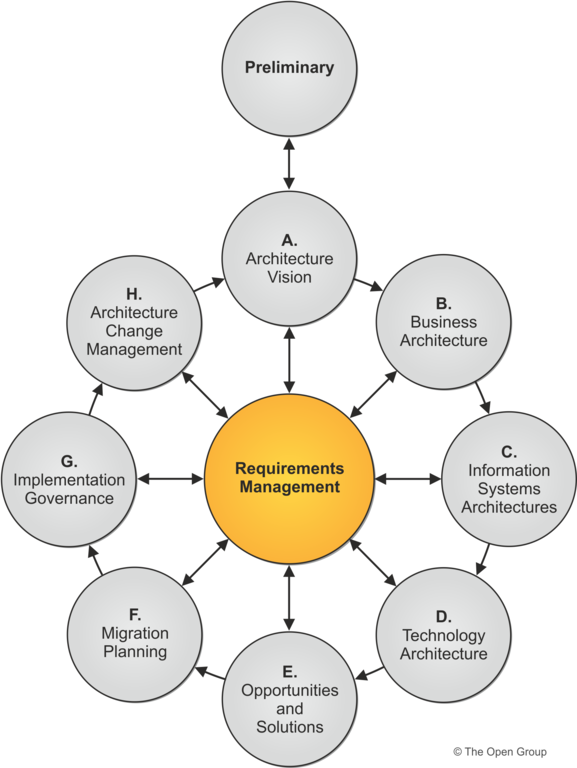
| You are here: | ||
| <<< Previous | Home | Next >>> |
This chapter looks at the process of managing architecture requirements throughout the ADM.

The objectives of the Requirements Management phase are to:
Inputs to the Requirements Management phase are:
The steps in the Requirements Management phase are described in the table below:
|
|
Requirements Management Steps |
ADM Phase Steps |
|---|---|---|
|
Step 1 |
|
Identify/document requirements - use business scenarios, or an analogous technique. |
|
Step 2 |
Baseline requirements:
|
|
|
Step 3 |
Monitor baseline requirements. |
|
|
Step 4 |
|
Identify changed requirements:
|
|
Step 5 |
Identify changed requirements and record priorities:
Notes
|
|
|
Step 6 |
|
|
|
Step 7 |
|
Implement requirements arising from Phase H. The architecture can be changed through its lifecycle by the Architecture Change Management phase (Phase H). The Requirements Management process ensures that new or changing requirements that are derived from Phase H are managed accordingly. |
|
Step 8 |
Update the Architecture Requirements Repository with information relating to the changes requested, including stakeholder views affected. |
|
|
Step 9 |
|
Implement change in the current phase. |
|
Step 10 |
|
Assess and revise gap analysis for past phases. The gap analysis in the ADM Phases B through D identifies the gaps between Baseline and Target Architectures. Certain types of gap can give rise to gap requirements. The ADM describes two kinds of gap:
A "gap requirement" is anything that has been eliminated by accident, and therefore requires a change to the Target Architecture. If the gap analysis generates gap requirements, then this step will ensure that they are addressed, documented, and recorded in the Architecture Requirements Repository, and that the Target Architecture is revised accordingly. |
The outputs of the Requirements Management process may include, but are not restricted to:
The Architecture Requirements Repository will be updated as part of the Requirements Management phase and should contain all requirements information.
When new requirements arise, or existing ones are changed, a Requirements Impact Statement is generated, which identifies the phases of the ADM that need to be revisited to address the changes. The statement goes through various iterations until the final version, which includes the full implications of the requirements (e.g., costs, timescales, and business metrics) on the architecture development. Once requirements for the current ADM cycle have been finalized then the Architecture Requirements Specification should be updated.
As indicated by the "Requirements Management" circle at the center of the ADM graphic, the ADM is continuously driven by the Requirements Management process.
It is important to note that the Requirements Management circle denotes not a static set of requirements, but a dynamic process whereby requirements for Enterprise Architecture and subsequent changes to those requirements are identified, stored, and fed into and out of the relevant ADM phases, and also between cycles of the ADM.
The ability to deal with changes in requirements is crucial. Architecture is an activity that by its very nature deals with uncertainty and change - the "grey area" between what stakeholders aspire to and what can be specified and engineered as a solution. Architecture requirements are therefore invariably subject to change in practice. Moreover, architecture often deals with drivers and constraints, many of which by their very nature are beyond the control of the enterprise (changing market conditions, new legislation, etc.), and which can produce changes in requirements in an unforeseen manner.
Note also that the Requirements Management process itself does not dispose of, address, or prioritize any requirements; this is done within the relevant phase of the ADM. It is merely the process for managing requirements throughout the overall ADM.
It is recommended that an Architecture Requirements Repository (see Part IV, 37.6 The Architecture Requirements Repository) is used to record and manage all architecture requirements. Unlike the Architecture Requirements Specification, and the Requirements Impact Assessment, the Architecture Requirements Repository can hold information from multiple ADM cycles.
The first high-level requirements are articulated as part of the Architecture Vision, generated by means of the business scenario or analogous technique.
Each phase of the ADM, from Preliminary to Phase H, must select the approved requirements for that phase as held in the Architecture Requirements Repository and Architecture Requirements Specification. At the completion of the phase the status of all such requirements needs to be updated. During the phase execution, new requirements generated for future architecture work within the scope of the current Statement of Architecture Work need to be documented within the Architecture Requirements Specification, and new requirements which are outside of the scope of the current Statement of Architecture Work must be input to the Architecture Requirements Repository for management through the Requirements Management process.
In each relevant phase of the ADM the architect should identify types of requirement that must be met by the architecture, including applicable:
When defining requirements the architect should take into account:
Deliverables in later ADM phases also contain mappings to the design requirements, and may also generate new types of requirements (for example, conformance requirements, time windows for implementation).
The world of requirements engineering is rich with emerging recommendations and processes for Requirements Management. The TOGAF standard does not mandate or recommend any specific process or tool; it simply states what an effective Requirements Management process should achieve (i.e., the "requirements for requirements", if you like).
The business scenarios technique is an appropriate and effective technique to discover and document business requirements. Business scenarios are described in detail in the TOGAF® Series Guide: Business Scenarios.
There is a large, and increasing, number of Commercial Off-The-Shelf (COTS) tools available for the support of
Requirements Management, albeit not necessarily designed for architecture requirements. The Volere website has a very useful list
of leading requirements tools (see www.volere.co.uk/tools.htm).
 return to top of page
return to top of page